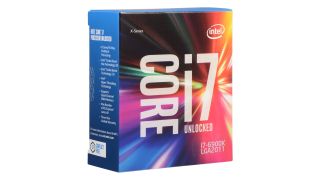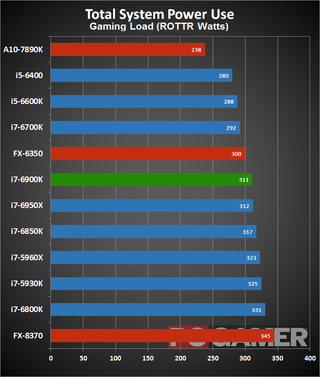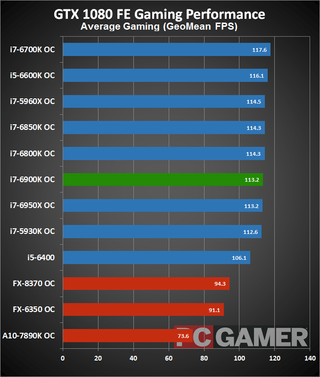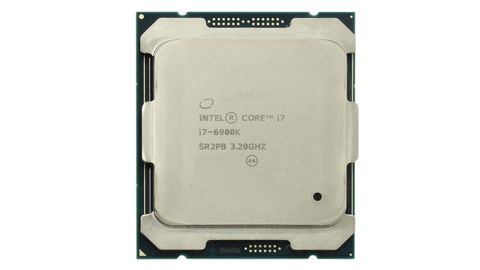Our Verdict
Eight cores is more than any game currently utilizes, but for CPU intensive tasks, Intel's i7-6900K easily beats their 6-core offerings. Just don't try gunning for the 10-core king of the mountain.
For
- Twice the cores of mainstream parts
- Overclocks very well
Against
- Not much better than the two-years-old i7-5960X
- Very expensive and not necessary for gaming PCs
PC Gamer's got your back
The law of diminishing returns is in full effect in the world of computer processors, and that's no more apparent than when looking at Intel's consumer CPUs. Going as far back as the first Core i7 processors, Intel has limited their 'mainstream' offerings to quad-core solutions; if you want more cores than that, you'll have to move up to their 'enthusiast' parts. The reason is that even today, nearly a decade after Intel launched its first consumer oriented quad-core processor (the Core 2 Extreme QX6700, if you're wondering), the use cases for more than four cores remain relatively limited.
Think about it for a minute. How much faster do web pages load if you have eight cores instead of four cores—or even two cores? Most of your everyday computing tasks will run just fine on a dual-core processor, which is why laptops and Ultrabooks have been gaining market share for years, and even smartphones are replacing computers for many tasks. That's not to say having more cores can't be useful, but if you're not routinely pushing your processor to 100 percent utilization, you probably won't benefit much if at all. Supercomputers, servers, and workstations will almost always benefit from having more cores, and faster cores, but for desktops and notebooks our performance demands have been relatively static for a while.
There's another reason most people don't really need to have 6-core and 8-core processors, and that's the rise of various forms of dedicated hardware and coprocessors. Recording and editing H.264 1080p video used to be an extremely processor intensive task, but most modern smartphones can do a fairly decent job at it now. The catch is that there's a loss in quality and flexibility associated with such an approach, so while your iPhone or Android device might be fine for your latest family YouTube video, TV and movie studios want something better.
I say all of this as an introduction to the Core i7-6900K in order to help establish the target audience. If you're reading PC Gamer to find out about the latest game releases and mods and you're wondering whether upgrading to a $1000+ CPU actually might help improve the gaming experience, the answer is an unequivocal no. But if you're also doing livestreams, editing your latest YouTube video, or creating character models and new levels for your favorite game, the difference between the mainstream i7-6700K and a chip like the i7-6900K can be very significant.

Perhaps the biggest issue with the i7-6900K is that it's not really all that different from the i7-5960X, a processor that launched over two years ago. That was Intel's then-best 'Extreme' part, with a starting price of $1000 (or $1060 if you wanted the box cooler). Two years later, the i7-6900K is incrementally faster and still includes most of the same features, and if you were hoping prices would come down you'll be sorely disappointed. In fact, the i7-6900K ends up being slightly more expensive than the i7-5960X! So if you bought the i7-5960X when it launched, this isn't the upgrade you're going to be looking for—that would be the 10-core i7-6950X, or wait for Skylake-X to launch next year.
I've covered most of this in the Broadwell-E review, so this is really just the short summary of the i7-6900K. (If you want to see all the individual test results, that's the place to find them.) Much like the i7-6800K and i7-6850K, this is an expensive part designed for a relatively small market, and while the two extra cores are enough to push it ahead of the 6800K and 6850K in many tasks, the 5960X has been fulfilling that need since it launched. Hopefully, with AMD's new Zen architecture slated to launch in early 2017, we'll see some healthy competition in the enthusiast CPU segment, but that still doesn't change the fact that CPUs are decidedly less sexy than many other components, including graphics cards.
What else do you get from the i7-6900K that you can't find in one of the less expensive Broadwell-E processors? Nothing, really, other than perhaps a better binned chip—the chips that end up as 6-core models may have been from a less 'prime' location on the silicon wafer, leading to potentially higher power use or areas that had to be disabled. Just as the 6850K mostly differs from the 6800K by adding 12 more PCIe lanes, the 6900K's major change is two extra CPU cores. Well, not quite—the 6900K also sports 20MB of shared L3 cache, compared to 15MB on the 6800K/6850K. That's mostly so L3 cache size scales with the number of CPU cores, but it might benefit a few memory intensive workloads.

Stock i7-6900K Performance



If you've read the other Broadwell-E articles, the above charts are nothing new, I've simply highlighted the i7-6900K this time. Gaming performance still favors the i7-6700K, at least with any current single-GPU solution (I'm working on putting together a comparison of SLI performance, but that's not ready yet). And if you're not running a GTX 1080, the gap between the various CPUs only grows smaller—that's why we typically recommend pairing mainstream GPUs like the GTX 1060 and RX 480 with an i5-6600K.
For processor intensive workloads like video editing, file archival, scientific calculations, or 3D modeling, the story is quite different. Here the i7-6900K has slightly lower clocks than the 6850K (or about the same clock speed as the 6800K), but it has 33 percent more cores. Overall, it ends up being 28 percent faster than the 6850K, so if you're doing video encodes that take an hour to complete on the 6850K, the 6900K could cut that down to about 45 minutes. And the 6900K is also slightly faster than the existing 5960X, but given the higher price it's difficult to imagine anyone forking out the money for what amounts to a 6.5 percent increase in performance on average.
In terms of power use while gaming, the 6900K ends up being the best of the Broadwell-E chips that I've tested, though that's not really the whole story. For a CPU-only workload, it ends up falling between the 6850K and the 6800K (the 6800K seems to be a bit power hungry, which is probably why it was cut down to 28 PCIe lanes and six cores).

Overclocked i7-6900K Performance
Overclocking of the i7-6900K is of course possible, and the dividends from doing so are similar to most of Intel's other unlocked CPUs. In this case, I was able to run this particular i7-6900K at 4.5GHz using 1.350V, which is a slightly higher clock than either the 6850K or 6800K could achieve. The 5960X meanwhile hit the same 4.5GHz, but at a lower 1.275V, which has been par for the course with Broadwell-E—all of my sample chips have required more voltage than Haswell-E when overclocking, though that may change over time.



Gaming performance improves by less than two percent on average, but CPU intensive tasks are at times more than 20 percent faster. (Note also that the MSI X99A Gaming Pro Carbon motherboard used for testing runs all the CPUs with 'enhanced' performance, basically letting the CPU hit maximum clocks in most cases even when all cores are loaded.)
Power use while overclocked is also higher, to the tune of around 30W while gaming, but that's not the real story. For a full CPU load, power use jumps from 173W at stock to 292W when overclocked. These are already 140W TDP parts, but with overclocking the CPU can hit power use of well over 200W—make sure you bring along a good CPU cooler if you're planning to overclock the i7-6900K.

More, more, more!
Anyone seriously considering a CPU like the i7-6900K should already have a good idea of why they need such a processor. For many tasks, Broadwell-E in general isn't substantially faster than a Skylake system, and the platform uses substantially more power—30-40W or more at idle and low loads, more than 100W higher at full load with overclocking. But if time is money for your computing tasks, the 6900K is anywhere from 35 to 75 percent faster than the mainstream i7-6700K. It's also more than three times as expensive, but professionals could potentially make up for the extra $750 in a matter of months.
The problem with the i7-6900K is that it's not substantially different than the existing i7-5960X. If you're the type of user where the i7-6900K makes sense, you're very likely also the sort of user that already bought an i7-5960X in 2014, and the only real upgrade worth making is the 10-core i7-6950X. But what about enthusiasts that simply want the baddest-assest (yeah, I made that up) gaming rig around? If dual Titan X cards are simply too much to contemplate but you're willing to spring for a GTX 1080 SLI setup, there might be a place for the 6900K. That could beat last year's Dream Machine, at a fraction of the cost (albeit without the fancy speakers, storage, and display).
Looking at the bigger picture, AMD recently demonstrated an engineering sample of their Zen processor, aka Summit Ridge. In the demonstration, running a Blender benchmark, the 8-core Zen chip clocked at 3.0GHz was just barely able to edge out an 8-core Broadwell-E chip (the i7-6900K) clocked at the same 3.0GHz. To be clear, we don't know how much power the AMD system was using or what the final clocks will be, and we don't have benchmarks for a wide selection of software—it's possible Zen may not end up being quite so competitive when it comes out in early 2017.
Whether AMD is able to come close to Broadwell-E in performance or actually beat it, the real hope is that AMD's pricing will be far more aggressive. Some have guessed that we could see AMD's 8-core parts in the $400-$500 price range, which would be awesome, but as with all forward-looking statements and early benchmarks, we don't really know what will happen yet. Personally, I'm pretty sure come January, we'll see a bit more excitement in the enthusiast CPU market—it can't be any worse than the current status quo.
As with the other Broadwell-E parts, the i7-6900K delivers great performance for its intended market, but the price and features leave it stranded in the middle ground limbo that sits between the 6800K and the 6950X. It's not a bad part, but it's also not the processor I'd recommend to most people. Either save your pennies and stick with the mainstream i7-6700K or i7-6800K, or go whole hog and grab the 10-core model. Anything else ends up being sort of a half measure.
Eight cores is more than any game currently utilizes, but for CPU intensive tasks, Intel's i7-6900K easily beats their 6-core offerings. Just don't try gunning for the 10-core king of the mountain.
Jarred's love of computers dates back to the dark ages when his dad brought home a DOS 2.3 PC and he left his C-64 behind. He eventually built his first custom PC in 1990 with a 286 12MHz, only to discover it was already woefully outdated when Wing Commander was released a few months later. He holds a BS in Computer Science from Brigham Young University and has been working as a tech journalist since 2004, writing for AnandTech, Maximum PC, and PC Gamer. From the first S3 Virge '3D decelerators' to today's GPUs, Jarred keeps up with all the latest graphics trends and is the one to ask about game performance.


